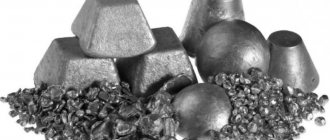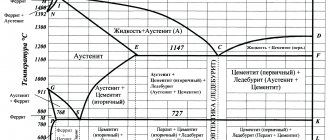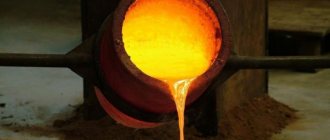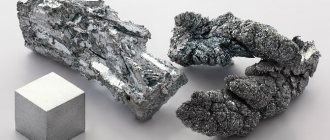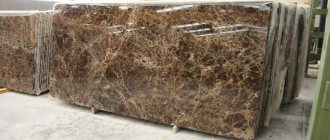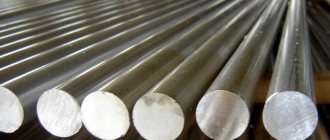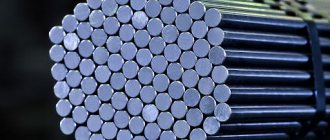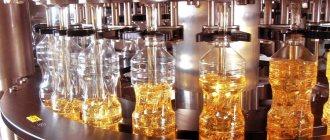TIN PRODUCTION.
Tin was one of the first metals to be used by man, and its many uses gave rise to thriving industries.
Tin production includes the mining and beneficiation of tin ore, as well as the smelting and refining of tin ( see also
TIN). Although tin is of industrial importance, its annual production is relatively small and rarely exceeds 250,000 tons. The predominant share of this volume is obtained from the cassiterite mineral, tin dioxide SnO2.
Placer deposits.
Such deposits contain predominantly fine-grained sands. The main methods of their development are dredging and sand pumping. With the dredging method, large bucket or suction dredges extract tin deposits from the bottom of rivers, artificial reservoirs, and even from the seabed. The dredge is a floating mining and processing unit that performs various gravity separation processes (screening, jigging and concentration on tables) and, by dumping waste rock astern, produces cassiterite concentrate.
When mining with sand pumps, the deposit is first opened by mechanical means. Then powerful water jets crush the ore and wash it into a storage pond at the lower level of the quarry. A submersible sand pump supplies a water-mud suspension to a washing gallery located at a higher level. The suspension flows through wash gates, which are long wooden trays. Heavy cassiterite settles to the bottom and is periodically selected for jigging and concentration on tables. The resulting cassiterite concentrate contains 70–76% tin.
Main players
Most of the metal reserves are concentrated in the Asian region, therefore the main players are represented by relevant companies, most of which are either private or traded on an exchange in China/Indonesia and are not available for purchase.
Therefore, if you want to make an exposure to tin, then one of the few options is Alphamin Resources - this is a company that mines tin in Central Africa and is traded on the Canadian and Johannesburg exchanges under the tickers AFM and APH, respectively. By the way, the Russian public company Seligdar also mines tin, although this is not their main business; the majority of their revenue comes from gold mining.
Alphamin Resources (TSXV:AFM, JSE:APH)
The company is one of the largest tin producers outside of China. Alphamin's mines and fields are located in the Democratic Republic of the Congo (Central Africa), so it's worth mentioning the geopolitical risk, which in this case is very significant. The company began mining recently, at the end of 2019, when the main deposit, the Bisie mine, began operating - this is one of the largest and richest tin mines in the world. Alphamin is not the sole owner of the mine, its share is 84%, also 5% belongs to the Congolese government and almost 11% to the South African industrial development department. In addition to Bisie, the company has a number of other production licenses near the main field. Now it is actively conducting geological exploration work at 2 sites: Mpama North and Mpama South.
In terms of production volumes, the annual output is about 10-11 thousand tons, which the company extracts from the main Bisie mine. Thus, Alphamin accounts for about 3-4% of the mined tin market. There is a potential increase in production due to the development and launch of the two Mpama deposits, but these should not be expected in the near future, and in the short term a small increase is expected due to the commissioning of a new tin refinery, which became operational on a permanent basis from July 2022 . At the same time, the Sn content in the ore is 4.5%, which is 4 times higher than the industry average. Such a high content and relatively low contamination with third-party elements affects the cost of production - Alphamin Cash Costs per ton are at a fairly low level.
The situation looks similar from the point of view of total costs, taking into account the capex for deposits, etc.
In general, it can be noted that at the current price of tin, all producers receive good margins, in contrast to the previous 5 years, when many worked in the red or on the verge of break-even. Considering that the world's tin reserves are quite large,
Primary deposits.
Individual vein deposits can be developed by open-pit mining. But more often, an inclined adit is passed in a slope, the slope of which ensures continuous drainage of water. In some cases, a vertical shaft is required. Jaw crushers and mills crush raw ore to a fine sand. Methods of further concentration depend on the nature of the ore. Separation of rock tailings and pyrite is usually carried out using gravity and flotation concentration methods. Some complex sulfide ores are roasted and leached in two stages to capture silver, gold, copper and lead. After firing, tin can be magnetically separated from iron and tungsten. Roasting and leaching are followed by gravity enrichment of the waste. Concentrates from primary deposits are poorer than concentrates from alluvial deposits. Thus, the tin content in typical Bolivian concentrates is 18–60%. Reduction and refining require more significant costs, as the processes are complicated by the presence of large quantities of other minerals.
Market Review
Tin (Sn) is a metal that has been used since the 17th century, when its properties in providing corrosion resistance to products became known. Over the past 100 years, the demand for tin has changed in several large leaps. At the beginning of the 20th century, the main applications were the food industry and the automotive industry. Then post-war economic growth, including a surge in automobiles and household appliances, provided a new impetus. And the latest jump in consumption since the 1990s was caused by the development of consumer electronics.
Currently, about half of the tin consumed is used in the form of solder on printed circuit boards in electronics, the rest of the demand is distributed between the chemical and food industries (almost 30%), batteries and a number of other applications.
However, the most interesting thing about tin is that it has great potential applications in many growing industries that will play a large role in the future. Mostly new important consumption markets will be the Internet of Things (IoT), green energy, electric vehicles, industrial robots, etc. Among all metals, tin has almost the widest application in new industries.
The market has been relatively balanced over the past 10 years, although there have been periods of slight surpluses in 2014 and deficits in recent years. It's also worth noting that about 30% of the metal's supply is mined by recycling obsolete electronics. According to forecasts, the market shortage is expected to continue in the future due to the use of the metal in new areas in which tin is quite difficult to replace.
Historically, over the past decades and to this day, the main production regions are China, Indonesia and South America. They account for more than 70% of metal production. Russia is in second place in terms of reserves, but production is minimal.
Myanmar is in second place in metal mining, and it is interesting that, unlike many countries that have been mining tin for a long time, the sector began to actively develop in Myanmar only 10 years ago. In most other countries where the bulk of tin has historically been mined, production has stagnated or declined in recent years.
Tin occurs naturally in the form of minerals, ores, or placers with relatively low concentrations of the element. Unlike rare earth metals, which occur together in nature, tin does not have a clear correlation with other elements - the geographical location of the mines and the associated composition of the ore play a role here - there are usually impurities of sulfur, iron, tungsten, tantalum and lithium are also found . To increase the tin content, various enrichment techniques are used at the mining site, resulting in a concentrate with a Sn content of about 50-70%. Next, this concentrate is sent to the plant, where additives in the form of sulfur are removed in furnaces and then using chemical reactions, and pure tin is obtained from the oxide. Intermediate processes can vary depending on the region and the composition of the primary raw material, which affects the cost of extraction and purification - the purer the source mineral, the less money will have to be spent on its enrichment and purification.
Now the price of tin is at its historical highs - since the beginning of this year, the metal has already increased in price by 85% to $37 thousand per ton. Taking into account the high prices and long-term potential for growth in demand for tin, let’s take a closer look at which companies mine it and whether there are any interesting ideas for investment among them
Smelting.
To restore cassiterite, it is melted with carbon-containing materials in reverberatory or special types of shaft furnaces. Tin mine furnaces have been used since ancient times; In them, charcoal, which serves as a reducing agent, is burned using blast, which is loaded in layers alternating with layers of cassiterite. The more common reverberatory furnaces use coal as fuel; they operate similarly to open hearth steel furnaces, with the ore mixed with anthracite and limestone. Furnaces of both types produce slags rich in tin (up to 25%). The slag is processed by melting at a much higher temperature with the addition of new amounts of reducing agent. The result is rough tin with a high iron content - the so-called iron furnace coating. The process requires strict control, otherwise the secondary slag will contain too high a percentage of tin.
Applications of tin
Tin is an extremely important component of the mixture in the process of manufacturing structural titanium alloys. Tin dioxide is a fairly good abrasive that is used to “finish” the surface of optical glasses. Previously, tin salts served as dyes for wool. In addition, this metal is widely used as a constituent element of anode material for a chemical current source. Experts say the use of tin to create lead-tin batteries is very promising. According to scientific research, at the same voltage as a lead battery, a lead-tin battery has 2.5 times higher capacity, as well as 5 times higher energy density per unit volume. Moreover, such a battery has a lower internal resistance. Tin is also used in the process of creating tinplate in the production of food containers, in solders for electronics, and in alloys from which bearings are made. Another popular alloy is pewter. Dishes are made from this material.
Electrolytic refining.
The electrolytic refining method was developed for use with highly contaminated Bolivian ores. The electrolyte contains 8% sulfuric acid, 4% cresol and phenolsulfonic acids and 3% divalent tin (Sn2+). Electrolysis baths and auxiliary equipment are approximately the same as for copper refining. Operating temperature 35° C. The purity of electrolytic tin (>99.98%) is higher than that of thermally refined tin. Additional purification using the zone melting method produces highly pure tin for semiconductor technology (99.995% Sn). see also
ALLOYS; MINERAL RESOURCES; ORE ENRICHMENT.
Tin brands
Tin alloys are often used as antifriction materials or solders. With the help of anti-friction compounds, specialists are able to preserve machines and equipment by reducing friction losses. And solders are used to hold together the metal components of mechanisms. Among the antifriction alloys, the most popular are babbitts. All grades of tin are produced in the form of ingots. According to the chemical composition, the following brands are distinguished:
- O1
- O1pch
- O2
- O3
- O4.
Story
Tin was known to man already in the 4th millennium BC. e. This metal was inaccessible and expensive, so products made from it are rarely found among Roman and Greek antiquities. There are mentions of tin in the Bible, the Fourth Book of Moses. Tin is (along with copper) one of the components of tin bronze, invented at the end or middle of the 3rd millennium BC. e.. Since bronze was the most durable metal and alloy known at that time, tin was a “strategic metal” throughout the “Bronze Age”, more than 2000 years (very approximately: 35-11 centuries BC).
Drop of molten tin
Isotopes
Main article: Tin isotopes
Natural tin consists of ten stable nuclides with mass numbers 112 (in a mixture of 0.96% by mass), 114 (0.66%), 115 (0.35%), 116 (14.30%), 117 (7. 61%), 118 (24.03%), 119 (8.58%), 120 (32.85%), 122 (4.72%) and 124 (5.94%). For some of them, double beta decay is energetically possible, but it has not yet been observed experimentally (2014) because the predicted half-life is very long (more than 1020 years).
Tin has the largest number of stable isotopes of all elements, which is due to the fact that 50 (the number of protons in tin nuclei) is the magic number - it constitutes a filled proton shell in the nucleus and thereby increases the binding energy and stability of the nucleus. Two doubly magic isotopes of tin are known, both of them are radioactive, since they are far from the beta stability band: neutron-deficient 100Sn (Z = N = 50) and neutron-rich 132Sn (Z = 50, N = 82).
Tin isotopes 117Sn and 119Sn are Mössbauer isotopes and are used in gamma resonance spectroscopy.
Content
- 1. History
- 2 Origin of the name
- 3 Being in nature
- 3.1 Deposits
- 3.2 Prevalence in nature
- 3.3 Forms of location
- 3.3.1 Solid phase. Minerals
- 3.3.2 Mineral forms proper
- 3.3.2.1 Native elements, alloys and intermetallic compounds
- 3.3.2.2 Tin oxide compounds
- 3.3.2.3 Tin sulfide compounds
- 3.3.3 Colloidal form
- 3.3.4 Forms of tin in the liquid phase
- 3.4 Industrial types of tin deposits
- 4 Production
- 5 Physical properties
- 6 Tin Plague
- 7 Application
- 8 Isotopes
- 9 Physiological action
